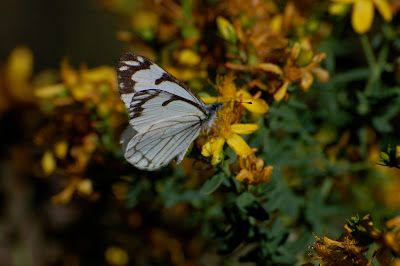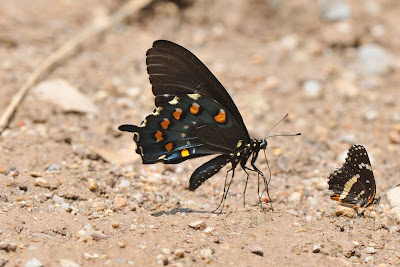This post will focus on some of the butterflies we saw out west on our Washington/Oregon/California trip back in the summer of 2008.
I was just barely interested in butterflies at this point so many of these are pretty terrible photos (which might not be identified correctly!). Either way, it's fun to revisit these places via photos.
This first butterfly is a type of "anglewing", a family of butterfly that really sparked my interest earlier that year. These fast-flying species are also known as "commas" for the silvery comma-shaped mark on the underwings. They are usually very bright on the upperwing but extremely dull and camouflaged on the underwing. This is a HOARY COMMA (Polygonia gracilis):
This butterfly is a type of tailless "hairstreak"; one that frequents arid regions in the interior West. If my memory serves me right, we were on an arid rim of Crater Lake when we spotted this male BEHR'S HAIRSTREAK (Satyrium behrii) patrolling for females:
Another hairstreak we saw was this HEDGEROW HAIRSTREAK (Satyrium saepium), apparently the most common brown hairstreak in the west:
I didn't see very many "blues" but one that I did manage to photograph was this ANNA'S BLUE (Plebejus anna):
One of the easiest butterflies to identify was this type of admiral. "Admirals" and "Sisters" are large and attractive butterflies that often have a white stripe through their wings. This is a LORQUIN'S ADMIRAL (Limenitis lorquini):
Another group of distinctive butterflies are the "ladies". Here in Iowa both the Painted Lady and American Lady can be seen. However, there is another species out west that we don't see here... this attractive WEST COAST LADY (Vanessa annabella) sat in beautiful light near Crater Lake:
Another butterfly we couldn't miss was the CALIFORNIA TORTOISESHELL (Nymphalis californica). We hadn't seen anything like it but there were THOUSANDS of these butterflies swarming several areas. Unfortunately you couldn't even drive down the road without hitting them! We read in the butterfly book that "adults are prone to long-range flights, sometimes in huge numbers". Indeed. Here is one:
Whites are familiar butterflies to most of us (like the Cabbage White). We didn't see a large diversity of whites on this trip and in fact, the only new white was this PINE WHITE (Neophasia menapia). It's ironic that we didn't even see it on a pine:
A lot of people like the parnassians, slow-flying butterflies related to swallowtails. Here is a CLODIUS PARNASSIAN (Parnassius clodius) we saw in a lush mountain roadside-meadow:
Easily the most difficult butterflies for me to identify are the fritillaries of the west. We saw several but my identification relied solely on whether or not I was able to photograph both the upper and underwings. For example, I tentatively identified this butterfly as a HYDASPE FRITILLARY (Speyeria hydaspe):
... and this is a ZERENE FRITILLARY (Speyeria zerene):
Maybe I overlooked most of the skippers on this trip; I don't recall seeing very many. One of the few grass-skippers we saw and identified was this JUBA SKIPPER (Hesperia juba):



















































